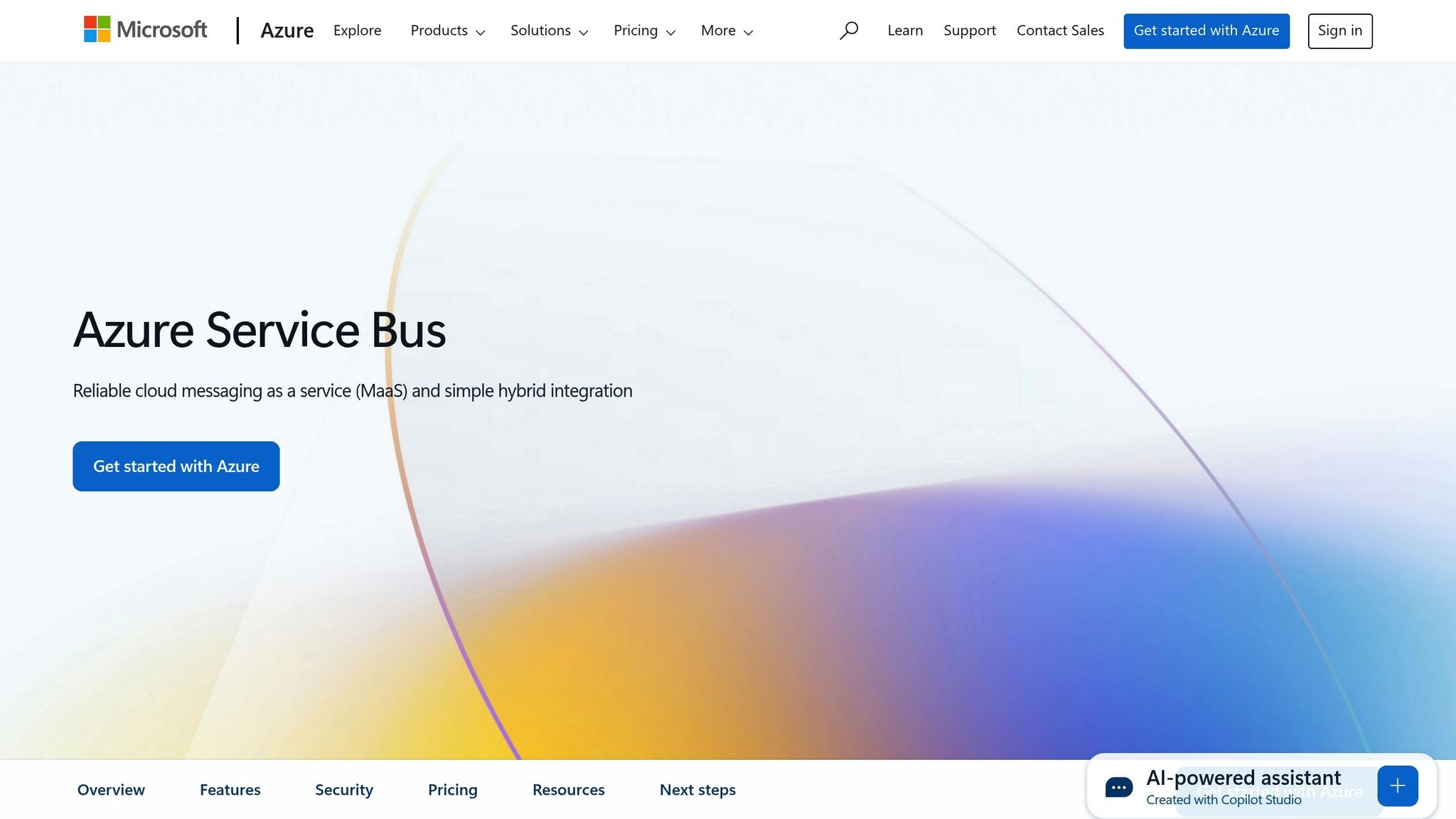Azure Service Bus Features Explained
Explore the key features of a fully managed messaging service that enhances communication, scalability, and security for UK SMBs.

Azure Service Bus is a fully managed message broker designed for seamless communication between systems. It supports queues for one-to-one messaging and topics for one-to-many messaging, making it ideal for different business needs. Here’s a quick breakdown of what it offers:
- Cost-Effective: Pay-as-you-go pricing in pounds (£) ensures you only pay for what you use.
- Scalability: Automatically handles fluctuating workloads.
- Reliability: Features like message sessions (FIFO delivery) and dead-letter queues ensure smooth operations.
- Security: Enterprise-grade encryption (AES-256), Role-Based Access Control (RBAC), and GDPR compliance.
- Flexibility: Options for scheduling, duplicate detection, and transactional messaging.
Quick Comparison: Queues vs Topics
| Feature | Queues | Topics |
|---|---|---|
| Pattern | One sender, one receiver | One sender, multiple receivers |
| Use Case | Order processing | Event notifications |
| Message Retention | Until processed/expired | Until all subscriptions process/expire |
| Storage | 80 GB | 80 GB per unit |
Whether you’re integrating systems, automating processes, or improving customer engagement, Azure Service Bus offers tools to simplify operations. For UK SMBs, it’s a scalable, secure, and cost-effective messaging solution.
Main Features
Message Types: Queues vs Topics
Azure Service Bus offers two primary messaging options: queues for one-to-one communication and topics for publish–subscribe scenarios. Queues ensure single-consumer message processing, while topics enable multiple subscribers to receive the same message simultaneously.
| Feature | Queues | Topics |
|---|---|---|
| Communication Pattern | One sender, one receiver | One sender, multiple receivers |
| Message Handling | Each message processed once | Each message processed by multiple subscribers |
| Typical Use Case | Order processing, task queuing | Event notifications, broadcast updates |
| Message Retention | Until processed or expired | Until all subscriptions process or expire |
| Maximum Storage | 80 GB | 80 GB per messaging unit |
Let’s now explore how Azure Service Bus manages message order.
Message Order Control
To ensure messages are processed in the exact order they are sent, Azure Service Bus uses message sessions. This feature guarantees First-In-First-Out (FIFO) delivery, which is crucial for operations requiring strict sequencing, such as financial transactions or multi-step workflows. For instance, in scenarios like order creation, payment processing, and shipping, message sessions ensure that operations occur in the correct sequence.
When a message fails to process, Azure Service Bus has a reliable system to handle these situations.
Failed Message Handling
Azure Service Bus addresses failed messages through Dead-Letter Queues (DLQ). If a message cannot be delivered or processed after multiple attempts, it is automatically moved to the DLQ. This approach prevents system blockages while keeping problematic messages intact for further investigation.
The service also allows configurable retry policies and sets a maximum delivery count. When the maximum is exceeded, administrators can inspect, troubleshoot, and decide whether to reprocess the messages. For those using the Premium tier, additional benefits include support for larger message sizes - up to 100 MB (compared to 256 KB in the Standard tier) - and enhanced processing reliability.
Intro to Azure Service Bus - The Power Behind Microservices

Extended Messaging Features
Azure Service Bus goes beyond basic messaging controls by offering tools that refine message scheduling, prevent duplication, and ensure transactional reliability.
Message Timing Controls
With Azure Service Bus, you can manage when messages are delivered using scheduling and deferral options. Scheduled delivery allows you to hold messages until a specific time - perfect for tasks like sending customer reminders or handling time-sensitive events. On the other hand, message deferral lets you delay processing until certain conditions are met, giving you flexibility in managing workflows.
Avoiding Duplicate Messages
To keep your systems clean and accurate, Azure Service Bus includes a duplicate detection feature. It temporarily stores message IDs to identify and discard repeated messages. This is especially useful in scenarios like financial transactions or inventory updates, where duplicates could cause major issues. You can customise the detection window, ranging from one minute to 24 hours, to align with your operational requirements.
Handling Multi-Step Operations
Azure Service Bus supports transactional messaging, allowing you to group multiple actions into one operation. If any step fails, the entire transaction can roll back, ensuring consistency. When paired with FIFO (First In, First Out)-enabled message sessions, this becomes a powerful tool for managing complex processes such as order fulfilment, approval workflows, or financial reconciliations. Additionally, integration with tools like Azure Functions makes it easier to build automated, multi-stage workflows that are both efficient and reliable.
Security Measures
To complement its reliable messaging features, Azure Service Bus incorporates robust security protocols to protect your operations, all while adhering to UK data regulations.
Data Protection Methods
Azure Service Bus employs AES-256 encryption to safeguard messages both during transit and at rest. Additional security measures include TLS encryption, private endpoints, Virtual Network Service Endpoints, and IP filtering for enhanced protection.
Access Management
Access control in Azure Service Bus is managed through Azure Active Directory using Role-Based Access Control (RBAC). This ensures permissions are clearly defined and tailored to specific roles.
| Role | Permissions | Use Case |
|---|---|---|
| Azure Service Bus Data Owner | Full access | System administrators |
| Azure Service Bus Data Sender | Send messages only | Application services |
| Azure Service Bus Data Receiver | Receive messages only | Processing services |
| Azure Service Bus Data Reader | View settings | Monitoring tools |
These role-based permissions align with UK data protection requirements, ensuring secure and efficient operations.
UK Data Rules
Azure Service Bus supports compliance with GDPR and ensures data residency within UK data centres. It also provides activity tracking for regulatory reporting and offers granular access controls. Regular security practices include access reviews, key rotation, monitoring, and network security configuration to maintain a high level of protection.
SMB Usage Tips
Making the most of Azure Service Bus can lead to better efficiency and help cut down on costs.
Reducing Costs
Choosing the right service tier is key to managing expenses effectively.
Here's a quick breakdown of the available tiers:
| Tier | Best For | Key Features |
|---|---|---|
| Basic | Simple queue-based messaging | Basic queue functionality |
| Standard | Advanced messaging | Topics, sessions, and dead-letter queues |
| Premium | Mission-critical workloads | Dedicated resources and consistent performance |
To keep costs under control, consider the following:
- Enable message batching: This reduces the number of billable operations.
- Monitor usage: Use Azure Cost Management to track and manage your spending.
- Set up auto-scaling rules: Adjust resources based on demand to avoid over-provisioning.
- Clean up unused namespaces: Regularly review and remove any resources that are no longer needed.
Speed Improvements
Optimising Azure Service Bus configurations doesn't just save money - it can also make your operations faster.
Here are some ways to enhance performance:
- Adjust message prefetch counts: Set these based on your processing capacity to minimise delays.
- Enable parallel message processing: If message order isn't a priority, this can significantly speed things up.
- Leverage the Premium tier: With dedicated resources, it ensures steady and reliable performance.
- Use proper partitioning: This is crucial for handling high-throughput scenarios effectively.
Connecting Azure Tools
Pairing Azure Service Bus with other Azure tools can unlock even greater performance and cost savings.
The Azure Optimization Tips, Costs & Best Practices blog suggests combining Service Bus with the following tools:
- Azure Functions: Ideal for event-driven processing.
- Logic Apps: Streamline workflows with automation.
- Event Grid: Distribute events in real time.
- Azure Monitor: Keep an eye on performance metrics.
To make the most of these integrations, follow these tips:
- Use managed identities: Securely enable service-to-service authentication.
- Optimise connection pooling and retry policies: Take advantage of built-in Azure SDK features.
- Track key metrics with Azure Monitor: Monitor indicators like message latency, CPU usage, active connections, and dead-letter queue counts to ensure smooth operations.
Summary
Key Points Review
Azure Service Bus offers a range of messaging features that can simplify and improve how small and medium-sized businesses (SMBs) in the UK manage their communications and operations. Here's a quick look at its standout features and their impact:
| Feature | Business Impact | SMB Benefit |
|---|---|---|
| Fully Managed Service | Eliminates the need for infrastructure management | Cuts down operational costs |
| Message Sessions | Ensures First-In-First-Out (FIFO) delivery | Provides dependable transaction handling |
| Dead-Letter Queues | Automatically manages failed messages | Boosts system reliability |
| Multi-Zone Support | Maintains high availability across regions | Strengthens business continuity |
For UK-based SMBs, these features mean access to reliable messaging tools without the headache of managing complex infrastructure. This foundation allows businesses to focus on growth while enjoying enhanced efficiency and resilience.
Next Steps for SMBs
UK SMBs looking to adopt Azure Service Bus can take the following steps to make the most of its capabilities:
-
Initial Setup and Configuration
Begin by creating a Service Bus namespace in either the UK South or UK West Azure regions. Opt for the Standard tier to strike a good balance between cost and features, including access to topics and dead-letter queues. -
Security Implementation
Secure your setup by enabling Shared Access Signatures (SAS), Role-Based Access Control (RBAC), and encryption. Additionally, configure authentication through Azure Active Directory for a more secure environment. -
Monitor Key Metrics
Use Azure Monitor to keep track of critical metrics such as:- Message latency
- Active connections
- Dead-letter queue counts
- Overall system throughput
For even greater efficiency, consider integrating Azure Service Bus with tools like Azure Functions and Logic Apps to automate workflows and build powerful business solutions.
For a deeper dive into managing costs and optimising performance, check out the Azure Optimisation Tips, Costs & Best Practices blog. It’s packed with insights tailored for SMBs scaling their operations on Microsoft Azure.
FAQs
How does Azure Service Bus ensure secure messaging and comply with UK data protection laws?
Azure Service Bus prioritises secure messaging by implementing encryption both at rest and in transit, safeguarding sensitive data from unauthorised access. Messages are encrypted using either Microsoft-managed keys or customer-managed keys via Azure Key Vault, allowing you to maintain full control over your encryption settings. It also incorporates role-based access control (RBAC) to ensure that only authorised users can access the system.
To meet UK data protection laws, including the UK GDPR and the Data Protection Act 2018, Azure Service Bus operates within Microsoft's globally recognised compliance framework. This framework aligns with international standards such as ISO 27001 and SOC 1/2/3, ensuring robust data security and privacy measures. Hosting your resources in Azure's UK-based regions further supports data residency requirements and compliance with local regulations.
What are the main differences between Azure Service Bus queues and topics, and when should you use each?
Azure Service Bus offers queues and topics as two distinct messaging options, each tailored to different communication needs.
Queues work best for point-to-point communication, where one sender delivers a message that is processed by a single receiver. This setup is perfect for tasks requiring sequential handling, such as processing customer orders or managing workflow steps.
Topics, on the other hand, support publish/subscribe (pub/sub) communication. When a message is sent to a topic, it can be received by multiple subscribers, each with individual subscriptions. This is ideal for scenarios like broadcasting stock updates to various systems or sharing events across multiple services.
Selecting the right option ensures your messaging setup is both efficient and scalable.
How can small and medium-sized businesses (SMBs) in the UK optimise costs and improve performance with Azure Service Bus?
Azure Service Bus provides a versatile solution for UK SMBs to manage messaging and integration, but keeping costs in check while maintaining performance demands thoughtful planning. The first step is choosing the right pricing tier for your needs - Basic, Standard, or Premium. For instance, Premium is well-suited for workloads that demand high throughput and minimal latency, whereas Standard often strikes a better balance for smaller businesses aiming to keep expenses manageable.
To improve performance, focus on refining your message processing patterns. Techniques like batching can help cut down on overhead, and dead-letter queues are invaluable for managing processing failures without disrupting ongoing workflows. Don’t forget to keep a close eye on your usage metrics in the Azure Portal. Regular reviews can help pinpoint inefficiencies and fine-tune resource allocation to better serve your operations.
For more guidance on optimising costs and performance across Azure, dive into expert recommendations on cloud architecture, security, and performance, all tailored to the needs of SMBs.




